
Human evolution is the evolutionary process within the history of primates that led to the emergence of Homo sapiens as a distinct species of the hominid family, which includes the great apes. This process involved the gradual development of traits such as human bipedalism and language, as well as interbreeding with other hominins, which indicate that human evolution was not linear but a web.
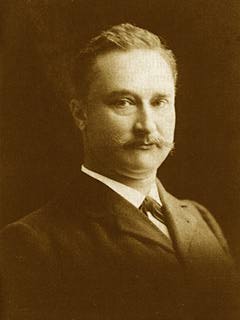
Marie Eugène François Thomas Dubois was a Dutch paleoanthropologist and geologist. He earned worldwide fame for his discovery of Pithecanthropus erectus, or "Java Man". Although hominid fossils had been found and studied before, Dubois was the first anthropologist to embark upon a purposeful search for them.

Meganthropus is an extinct genus of non-hominin hominid ape, known from the Pleistocene of Indonesia. It is known from a series of large jaw and skull fragments found at the Sangiran site near Surakarta in Central Java, Indonesia, alongside several isolated teeth. The genus has a long and convoluted taxonomic history. The original fossils were ascribed to a new species, Meganthropus palaeojavanicus, and for a long time was considered invalid, with the genus name being used as an informal name for the fossils.
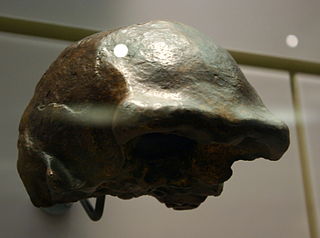
Solo Man is a subspecies of H. erectus that lived along the Solo River in Java, Indonesia, about 117,000 to 108,000 years ago in the Late Pleistocene. This population is the last known record of the species. It is known from 14 skullcaps, two tibiae, and a piece of the pelvis excavated near the village of Ngandong, and possibly three skulls from Sambungmacan and a skull from Ngawi depending on classification. The Ngandong site was first excavated from 1931 to 1933 under the direction of Willem Frederik Florus Oppenoorth, Carel ter Haar, and Gustav Heinrich Ralph von Koenigswald, but further study was set back by the Great Depression, World War II and the Indonesian War of Independence. In accordance with historical race concepts, Indonesian H. erectus subspecies were originally classified as the direct ancestors of Aboriginal Australians, but Solo Man is now thought to have no living descendants because the remains far predate modern human immigration into the area, which began roughly 55,000 to 50,000 years ago.

Homo is the genus that emerged in the genus Australopithecus that encompasses the extant species Homo sapiens, plus several extinct species classified as either ancestral to or closely related to modern humans, most notably Homo erectus and Homo neanderthalensis. The genus emerged with the appearance of Homo habilis just over 2 million years ago. Homo, together with the genus Paranthropus, is probably sister to Australopithecus africanus, which itself had previously split from the lineage of Pan, the chimpanzees.

Java Man is an early human fossil discovered in 1891 and 1892 on the island of Java. Estimated to be between 700,000 and 1,000,000 years old, it was, at the time of its discovery, the oldest hominid fossils ever found, and it remains the type specimen for Homo erectus.

Sangiran is an archaeological excavation site in Java in Indonesia. According to a UNESCO report (1995) "Sangiran is recognized by scientists to be one of the most important sites in the world for studying fossil man, ranking alongside Zhoukoudian (China), Willandra Lakes (Australia), Olduvai Gorge (Tanzania), and Sterkfontein, and more fruitful in finds than any of these."
The year 1891 in archaeology involved some significant events.

Gustav Heinrich Ralphvon Koenigswald was a German-Dutch paleontologist and geologist who conducted research on hominins, including Homo erectus. His discoveries and studies of hominid fossils in Java and his studies of other important fossils of south-eastern Asia firmly established his reputation as one of the leading figures of 20th-century paleo-anthropology.

Human taxonomy is the classification of the human species within zoological taxonomy. The systematic genus, Homo, is designed to include both anatomically modern humans and extinct varieties of archaic humans. Current humans have been designated as subspecies Homo sapiens sapiens, differentiated, according to some, from the direct ancestor, Homo sapiens idaltu.

Homo erectus is an extinct species of archaic human from the Pleistocene, with its earliest occurrence about 2 million years ago. Several human species, such as H. heidelbergensis and H. antecessor, with the former generally considered to have been the ancestor to Neanderthals, Denisovans, and modern humans, appear to have emerged within the possibly Asian populations of H. erectus. Its specimens are among the first recognizable members of the genus Homo. H. erectus was the first human ancestor to spread throughout Eurasia, with a continental range extending from the Iberian Peninsula to Java. Asian populations of H. erectus may be ancestral to H. floresiensis and possibly to H. luzonensis. The last known population of H. erectus is H. e. soloensis from Java, around 117,000–108,000 years ago.

Margarethe Lenore Selenka-Heinemann was a German zoologist, anthropologist, feminist and pacifist. She researched apes and led scientific expeditions to the Dutch East Indies.
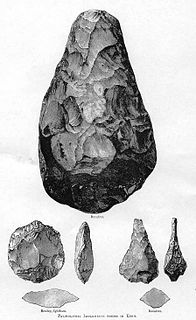
The oldest undisputed examples of figurative art are known from Europe and from Sulawesi, Indonesia, dated about 35,000 years old . Together with religion and other cultural universals of contemporary human societies, the emergence of figurative art is a necessary attribute of full behavioral modernity.

Prehistoric Indonesia is a prehistoric period in the Indonesian archipelago that spanned from the Pleistocene period to about the 4th century CE when the Kutai people produced the earliest known stone inscriptions in Indonesia. Unlike the clear distinction between prehistoric and historical periods in Europe and the Middle East, the division is muddled in Indonesia. This is mostly because Indonesia's geographical conditions as a vast archipelago caused some parts — especially the interiors of distant islands — to be virtually isolated from the rest of the world. West Java and coastal Eastern Borneo, for example, began their historical periods in the early 4th century, but megalithic culture still flourished and script was unknown in the rest of Indonesia, including in Nias, Batak, and Toraja. The Papuans on the Indonesian part of New Guinea island lived virtually in the Stone Age until their first contacts with modern world in the early 20th century. Even today living megalithic traditions still can be found on the island of Sumba and Nias.

The Mojokerto child, also known as Mojokerto 1 and Perning 1, is the fossilized skullcap of a juvenile early human. It was discovered in February 1936 near Mojokerto by a member of an excavation team led by Ralph von Koenigswald. Von Koenigswald first called the specimen Pithecanthropus modjokertensis but soon renamed it Homo modjokertensis because Eugène Dubois – the discoverer of Java Man, which was then called Pithecanthropus erectus – disagreed that the new fossil was a Pithecanthropus. The skullcap is now identified as belonging to the species Homo erectus.

The terms Anthropopithecus and Pithecanthropus are obsolete taxa describing either chimpanzees or archaic humans. Both are derived from Greek ἄνθρωπος and πίθηκος, translating to "man-ape" and "ape-man", respectively.

The region of Southeast Asia is considered a possible place for the evidence of archaic human remains that could be found due to the pathway between Australia and mainland Southeast Asia, where the migration of multiple early humans has occurred out of Africa. One of many pieces of evidence is of the early human found in central Java of Indonesia in the late 1800s by Eugene Dubois, and later in 1937 at Sangiran site by G.H.R. van Koenigswald. These skull and fossil materials are Homo erectus, named Pithecanthropus erectus by Dubois and Meganthropus palaeojavanicus by van Koenigswald. They were dated back to c. 1.88 and 1.66 Ma suggested by Swisher et al. by analysis of volcanic rocks.
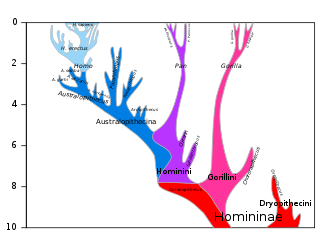
"Missing link" is a non-scientific term for a hypothetical or recently-discovered transitional fossil. It is often used in popular science and in the media for any new transitional form. The term originated to describe the hypothetical intermediate form in the evolutionary series of anthropoid ancestors to anatomically modern humans (hominization). The term was influenced by the pre-Darwinian evolutionary theory of the Great Chain of Being and the now-outdated notion (orthogenesis) that simple organisms are more primitive than complex organisms.
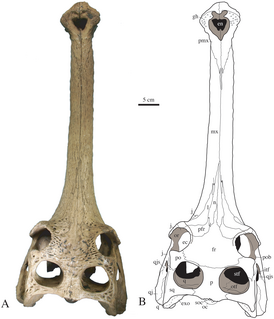
Gavialis bengawanicus is an extinct species of crocodilian that is related to the modern Indian gharial. Fossils have been found in Thailand and Indonesia. The type locality is at Trinil.
The Pseudodon shell DUB1006-fL or Pseudodon DUB1006-fL is a fossil freshwater shell of Pseudodon vondembuschianus trinilensis found at Trinil, Java, Indonesia. The shell has a zigzag engraving supposedly made by Homo erectus, which could be the oldest known anthropogenic engraving in the world.




















